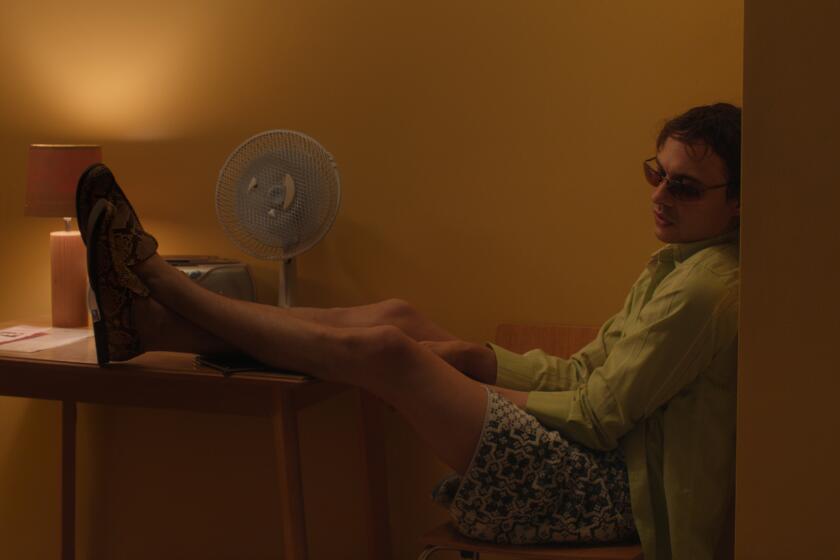The true hope and glory
- Share via
“MEMORY is definition of life,” director John Boorman writes in his gracefully composed and haunting autobiography. Yet memory of the kind he is talking about -- highly personal and delicately shaded -- is a subject mostly excluded from movies. It does not directly inform them the way it does so many, perhaps most, seriously intended novels.
Movies are good at evoking the quasi-mythic universal imaginings that we all share (romantic dreams, scary nightmares, comic humiliations), but they are not much interested in examining specific cases, those individual experiences that shape a single protagonist’s life as texts, subtexts or pretexts. Boorman’s own “Hope and Glory” is one notable exception to this general rule. So are Francois Truffaut’s “The 400 Blows” and Barry Levinson’s “Diner.” But too much subjective specificity spoils the Jungian broth, to say nothing of the box office take. So the rest is pretty much silence -- broken, occasionally, by symbolic autobiographical gestures, a “personal” sequence here or there in a film whose real business is being meta-mythic or, more commonly, putting as many bottoms as possible in the seats on opening weekend.
So it has been for the highly aspiring Boorman, as “Adventures of a Suburban Boy” demonstrates. He begins with the materials that informed “Hope and Glory,” the observant little boy making a brave beginning on life while the bombs of the Blitz rain down, eventually rendering his home uninhabitable. It’s all engagingly here again: the distant, disappointed father, the restless, pretty mom who takes a kindly lover and, most of all, and more richly than in the film, the life Boorman made for himself after he became homeless.
There was a harsh Catholic school (even though he was not a Catholic), which disabused him of conventional Christianity (but not of his spiritual yearnings) as well as interest in formal education (but not in the pursuit of enlightenment). Most important to him was the River Thames, on which and in which he found solace, a near-death experience and a comforting stream that runs through his life and work: “On bad nights, when the black dog is on my back, I still summon the consoling river from my childhood and let it flow through my mind, soothing fears and washing away anxiety.”
Rivers, of course, are a force in films other than “Hope and Glory.” It is what bears his protagonists to their hard destinies in his most popular film, “Deliverance.” The mighty Amazon is an ever-present threat in “The Emerald Forest,” which was shot in the Brazilian rain forest, the most challenging of the many difficult locations Boorman has embraced in his work.
Writing about that film, he asks: “Why do I relish this kind of adversity and thrive under it? What unconscious impulse makes me court danger? Why do I drive myself and others to the edge? Does it go back to my childhood in the war? Am I somehow contriving to repeat the conditions of the Blitz when I was in the midst of chaos and fear and falling bombs?” It seems, to the reader, a very reasonable guess. But this passage does not, by any means, fully explain the complexities of his life -- or even of his filmography.
He is, assuredly, one of the most adventurous filmmakers of his time. In addition to the rugged locales already named, he has shot on remote South Sea islands (with his crew near to revolt) and in the jungles of Southeast Asia. Even when he works closer to home (he has lived in County Wicklow, Ireland, for four decades) his subjects are not easy -- “Zardoz,” a deeply weird sci-fi epic, or “Excalibur,” his wonderfully romantic take on Arthurian legend. And he throws himself into them with combative fury. He is not shy in his memoirs about naming the studio names that have thwarted his ambitions by cutting his budgets or simply turning their backs on his most beloved projects, including an early attempt at “The Lord of the Rings.”
This suggests, accurately I think, that his main line is high romanticism, but it doesn’t explain some of his most arresting work. I think of that cult favorite, “Point Blank,” a numbed, fragmented tale of affectless violence, with its chilling central performance by Lee Marvin (who is one of Boorman’s favorite people). Or what I believe to be his best film, “The General,” the true, brutal history of Martin Cahill, a Dublin crime boss who makes all previous movie gangsters look like pussycats. I mean, where else have you ever seen a suspected informer crucified, in a richly detailed, totally unblinking sequence, on a pool table?
It is hard to reconcile these films with the sweet-souled “Hope and Glory.” Or with the woozy, indeed risible, mysticism of his “Exorcist” sequel, “The Heretic,” a flop that almost cost him his career. Or with the tree-hugger Boorman turns into when he’s between pictures and recuperating in his Irish glen. It is to his credit that, in this memoir, he doesn’t try. He just sets forth his adventures in his coolly elegant prose and allows us to make what we will of them. Which is to say that his is, unlike most show biz memoirs, a writerly book.
This should not surprise us. He was a writer before he was a director; it is what he did instead of going to college. He more or less wrote himself into his filmmaking career at the BBC, and he continues to write or co-write his movies. For years, on the side, he co-edited the excellent book-length film journal Projections. One gets the sense, sometimes, that his exertions as a director, however deeply he believed in his projects, were designed to test his courage and temper his spirit, to make a man of him worthy of a book -- this book, as it happens.
Boorman is, I think, the last of that breed of lean, fit, spiritually hungry Englishmen who ventured forth from their comfy little island to the farthest, hottest corners of the old colonial world -- men like T.E. Lawrence and Boorman’s friend, David Lean. They went, partly, for the sheer adventure of it, partly because they loved trying to pull off their vast, half-mad schemes in insalubrious climes, mostly because it was the only way they could think of to purify their souls. In a book replete with sharply etched portraits, none is more heartbreaking than Boorman’s picture of the once-heroic Richard Burton in “The Heretic” making “no contribution to the enterprise. I told him what was required and he did it. If I asked him to adjust his reading, he simply changed it without comment. He expressed no preference, he had no view of the character.... He acted from the neck up, face and voice. His body was rigid, completely inexpressive.”
For Boorman, staring into this burnt-out face was like staring into the face of death. Or the disapproving countenance of the little England the Nazis bombed away for him one winter’s night when he was 6. He calls that chapter “War to the Rescue.” He’s been keeping his war going, one way and another, ever since -- 60 years of relentless conflict, to which this richly rewarding book by no means signals a truce.
More to Read
Only good movies
Get the Indie Focus newsletter, Mark Olsen's weekly guide to the world of cinema.
You may occasionally receive promotional content from the Los Angeles Times.







